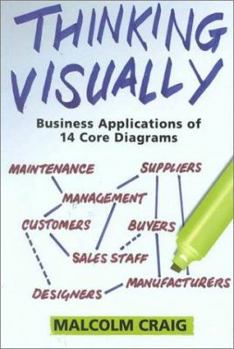Thinking Visually: Business Applications of 14 Core Diagrams
Select Format
Select Condition 
Book Overview
Some people make use of diagramming quite naturally, without prompting. Others would rather use a thousand words than a simple, quickly drawn diagram. This is an introduction to the world of diagrams.... This description may be from another edition of this product.
Format:Paperback
Language:English
ISBN:082644833X
ISBN13:9780826448330
Release Date:January 2000
Publisher:Thomson Learning
Length:168 Pages
Weight:0.76 lbs.
Dimensions:9.3" x 0.8" x 6.3"
Customer Reviews
3 ratings
Terribly denying of R-Mind/totality, Poorly written, & Crucial Skill, grrr
Published by Thriftbooks.com User , 19 years ago
This book is written by someone who is unshakeably certain that R-Mind ( right-hemisphere-dominant mind ) does not exist, & cannot exist, & who discounts the split-brain-person results & discoveries of the past decades ( read "The New Drawing on the Right Side of the Brain" ( Betty Edwards Ph.D ) to know-about some of it, but WORK-THROUGH the book to *understand* the fundamental difference between R-Mind knowing and L-Mind knowing, by *experiencing* it ). . . To quote the falsity ~. . .how the two halves of the brain can be seen, METAPHORICALLY[emphasis-mine], as handling information in opposite ways, either verbally or visually. Although there is little scientific evidence for such a claim. . .~ Baloney. Experience it: nearly anyone can ( hell, even the ultra-autistic "Nadya", IIR-her-name-C, was R-Mind-mode until that was broken from her by training, to satisfy her parents, want for a More Normal autistic child. . . ) Anyways, he's so linear/language/"logic" centred that he *cannot* notice how unclear he is being in his writing, or that is the charitable assessment, perhaps. . . However. . . Diagramming is one of the *core* skills needed by any competent mind, nowadays. The book "The Power of the 2x2 Matrix" is another core-skill book ( related to diagramming, having-to-do-with schema, and perceiving/knowing ). "Presenting to Win" is another core-skill book. Saxon Math books are another. "The Feiner Points of Leadership" ( Feiner ) is another. "The Definitive Business Plan" ( Stutely ) is another. UNfortunately, I don't know any better diagramming-competence book, so it's stuck in the NEED category, until I can get a good alternative. If you know of a better one, or can write one yourself, get the info here, or do it! Cheers, eh?
Extraordinary tool for writers and analysts
Published by Thriftbooks.com User , 24 years ago
As an IT consultant I do a lot of writing and create a lot of graphics to reinforce my words. Before discovering this gem my primary graphics reference was Information Graphics by Robert L. Harris, which is a comprehensive encyclopedia of technical graphics. Thinking Visually will not replace that book, but will augment it because this book is more of a how-to and is focused on 14 basic diagrams that I find myself using in one variation or another in nearly every project. The book is divided into three parts: (1) Introduction to Diagramming, which is among the best descriptions of diagramming and how to approach it that I've had the pleasure of reading; (2) APplying the Core Diagrams, and (3) Introduction to Diagramming, which is an extension of Part 1 that wraps up the book with excellent advice.Part 2 is the heart of the book. The core Diagrams are divided into six groups: (1) MAPPING THE BUSINESS (System Maps, Mind Maps), (2) RELATIONSHIP AND INFLUENCE (Relationship, Tree, Influence), (3) CONTROL IN BUSINESS (Input/Output, Control), (4) CAUSATION (Multiple Cause, Fishbone [also called Ishikawa], Sign), (5) CHANGE (Force-field, Window), (6) FLOW (Flow, Ring).Many of the diagrams have multiple instances. For example, flow diagrams can take the form of flow process, blocks, algorithms (flow charts) or network diagrams. Likewise, window diagrams take on many different forms, including strength/weakness/opportunity/threat (SWOT), quad matrices (such as the "Boston Matrix"). This extends the 14 core diagrams into many more because of the variations, with all of the major ones discussed in this book.What I especially like is the way the author presents each diagram: overview of the diagram, business application, business purpose and summary and conventions. When variations are discussed, such as a critical path network diagram derived from a flow, the same treatment is given. As I read through this book familiarizing myself with these basic tools I discovered that my primary software tool, Visio, contained stencil sets for many of these diagrams, including Mind Mapping, SWOT Fishbone and many more. I also liked the final part of the book because it contains valuable advice on managing information with the core diagrams - especially developing diagrams that convey information instead of resulting in information overload. The chapter on diagramming theory and some of its pitfalls was also excellent. Finally, Appendices A and B, only two pages, are incredibly useful because they map the core diagrams to themes (Appendix A) and to management activity (Appendix B). These make selecting the right tool for the right job easy, and their inclusion is a nice touch of added value.I cannot praise this book highly enough. It has quickly become one of my most valuable tools and has also enlightened me on a number of issues and factors related to effectively selecting and using diagrams. It merits 5 stars!
Excellent reference to graphical representation
Published by Thriftbooks.com User , 24 years ago
This is an excellent book of templates for graphical visulization of complex information. I think that this book belongs right on the bookshelf of anyone who uses line graphics for research and business...right next to Tufte's classics. Highly recommended.






